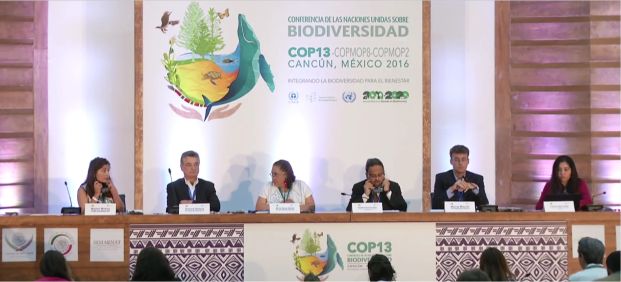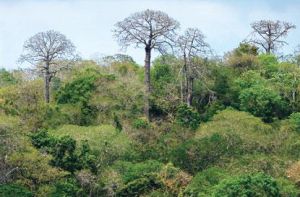GLOBE ACTIVITIES AT COP26
The implementation of the Convention on Biological Diversity (CBD) relies entirely on domestic action through policies and, ultimately, national legislation. Ultimately, only legislators have the capacity to edict solid rules and give clear directions for the kind of social and economic changes that the conservation of our biodiversity requires.
The success of that legislation will depend not only on the merit of each individual bill, but also on whether, taken as a whole, they offer a clear and coherent framework for action, free of contradictions.
This is the vision that led GLOBE International to launch the project ‘Integrated Multi-purpose Forest Governance for the National Delivery of Sustainable Development, Biodiversity Objectives’ in Mexico and Colombia in partnership with the Secretariat of the Convention on Biological Diversity (CBDS) and with the generous support of the Japan Biodiversity Fund (JBF). This project aimed at assessing how national forest governance frameworks are responding to the challenge of concurrent policy targets regarding forests.
Forests, because of the quantities of carbon they absorb and stock, the number of species they host and the variety of services they provide to local populations and the national economy, are a key ecosystem at the juncture of these overlapping policy objectives for development, climate and the conservation and sustainable use of biodiversity.
The outputs of the project were presented at the CBD COP13 Legislators Forum in Cancun, Mexico, in December 2016, and in two national parliamentary fora in Mexico City and Bogota respectively, to raise awareness amongst Mexican and Colombian members of Congress on the importance of these issues and help them navigate their complex interconnections.
Context
This project was based on three COP decisions: X/36 (para. 5) which requests the Executive Secretary (ES) to further build capacity on how forest biodiversity could be better addressed in national biodiversity and forest policies such as NBSAPs and national forest programmes, and in sustainable forest management practices; X/33 (para. 8) which requests the ES to convene an expert workshop to enhance coordination of capacity-building efforts on biodiversity and the conservation of forest; and XI/3 (para. 12(f) which requests the ES to promote collaboration on biodiversity with forestry and other relevant sectors at the national level.
Once just managed for the extraction of a limited number of commodities, forest ecosystems are now recognized for a broader range of functions and services that underpin economic development and human well-being. As a result, forests have come under the attention of many international agendas and associated national commitments such as the Sustainable Development Goals (SDGs), the Strategic Plan for Biodiversity 2011-2020 and the Reduction of emissions from deforestation and forest degradation, conservation of forest carbon stocks, sustainable management of forests and enhancement of forest carbon stocks in developing countries (REDD+).
In order to manage the complexity arising from the concurrent, interconnected and sometimes conflicting objectives of biodiversity conservation, climate mitigation and adaptation and sustainable development, several countries are in the process of reviewing their forest governance frameworks.
As countries analyze options and opportunities to reform existing frameworks, a risk may arise that competing stakeholder views and key issues are overlooked or not reconciled. The necessity to integrate new dimensions in the management of forests, such as result-based carbon payments or other ecosystem services, as well as clarify land rights and tenure, may lead to the development of new institutions that challenge control exerted by previously established ones and lead to a fragmentation and lack of coherence in the governance of forests. In many countries, the policy and legal frameworks need reform, including by eliminating inconsistencies and contradictions and by harmonizing forest-related laws with those in other sectors.
On the other hand, some of the reforms needed for the pursuit of a given forest-related objective (e.g. climate mitigation through implementation of REDD+) may work in synergy with other objectives, such as biodiversity conservation, depending on how they are implemented.
Countries can adopt a variety of approaches to foster the process of integration, including through the establishment of inter-ministerial taskforces; joint programming, planning and funding; integrated land use planning; sustainable use of biodiversity; standards/safeguards or certification schemes and shared information and monitoring systems. Such improvements that allow for enhanced cooperation and coherence in forest governance are highly specific to the national context. As such, they require an acute understanding of the institutional set up and legislative landscape, in order to identify opportunities for targeted reforms.
Objectives
One way of fostering coherence and effectiveness in forest governance is to build the knowledge base and capacity of stakeholders and decision-makers on the interconnectedness of these different agendas, the importance of consolidating actions under each of them and ensuring that they are implemented and/or enforced. Accordingly, the objectives of the project were, within the two target countries:
- To assess how national forest and climate governance frameworks are evolving in Colombia and Mexico and integrating the countries’ national biodiversity priorities, in a manner that supports Sustainable Development Goals;
- To inform future decision-making on forest and climate governance through a participatory and consultative stakeholder process, seeing that compliance with forest laws can best be achieved as an outcome of forest governance reform processes that enjoy the support of all stakeholders;
- To report on innovative approaches for balancing and incentivizing a broad range of forest services in forest governance frameworks, taking into account the concurrent demands on forests arising from the climate, biodiversity and sustainable development agendas;
- To foster the exchange of experiences between countries on potential reforms and mechanisms that allow for enhanced cooperation, coordination and integration between the work of relevant governmental and non-governmental actors in the pursuit of multiple forest-based policy objectives.



